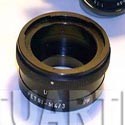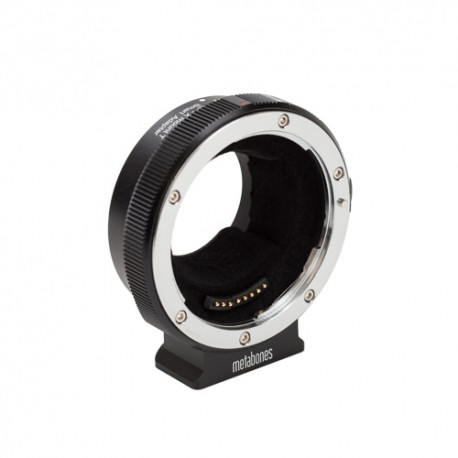Cart
0
Product
Products
(empty)
No products
To be determined
Shipping
0,00 €
Total
Product successfully added to your shopping cart
Quantity
Total
There are 0 items in your cart.
There is 1 item in your cart.
Total products
Total shipping
To be determined
Total
MB_EF-X-BT1 Metabones Canon EF Lens to Fuji X mount T Smart Adapter
3340
New product
MB_EF-X-BT1 Use your Canon-EF lenses on the FUJI X mount camera
In stock
Warning: Last items in stock!
Data sheet
| Camera Mount | Fuji X |
| Lens mount | Canon EOS |
| Marca | Metabones |
| Discount | 10% |
More info
Canon EF Lens to Fuji X mount T Smart Adapter
Electronic
- Canon EF mount lens to Fujifilm X-mount camera.
- Autofocus. Phase-detection autofocus (PDAF) is supported no matter which AF lens is used. Adapters support PDAF by translating pertinent metadata about the optics between the lens interfaces. In this way, broad support of the widest range of lenses is made possible.
- Lens iris/aperture is set by the controls on the camera body.
- Optical image stabilization (IS) lens support.
- Smooth iris support with the latest Canon (2009+), Tamron (SP series 2013+) and Sigma (2016+) lens models.
- Focal length and aperture are adjusted in EXIF (see note 3).
- Store EXIF data (lens name, focal length and maximum/minimum aperture) for one manual lens in the adapter.
- Parallax correction on the X-Pro series rangefinders is also supported.
- LED indicator shows communication status.
- Powered by camera body. With most lenses, no external power source required.
Mechanical
- Flocking to reduce internal reflection.
- Rubber gasket protects the X-mount connection from dust and moisture.
- Aluminum alloy and brass construction with chromium plating.
- Satin surface finish.
- Detachable tripod foot compatible with Arca Swiss Style ball head, such as Markins and Photo Clam or attach to quick release plate by a 1/4"-20 screw.
Limitations
- Each lens needs to go through a calibration procedure <click to view> when first used. EF-X Mount Speed Booster ULTRA or EF-X Mount Smart Adapter will gather metadata by turning focus to infinity and minimum when the power is turned ON for the first time. If the lens has a focus limiter switch, set it to FULL prior to turning on the camera. Set camera to AF-S and use the autofocus a few times, although during the initial calibration stage the AF performance may be subpar and you may experience difficulty locking onto subjects. For a zoom lens, it is also necessary to zoom to both the wide end and the telephoto end of the zoom range. Turn off the camera to complete the calibration procedure. If calibration is successful the Speed Booster ULTRA or Smart Adapter will no longer turn focus to minimum the next time the camera starts up. If this calibration procedure is not completed properly, there may be problems such as excessive hunting, difficulty locking onto targets, inaccurate AF, incorrect parallax correction on X-Pro series and incorrect distance scale display on the camera (if enabled).
- Continuous autofocus (AF-C) and video autofocus may not work on some cameras such as X-T100. Increasing FOCUS SENSITIVITY and decreasing AF SPEED is required under the AF-C CUSTOM SETTING (MOVIE) menu.
- For video, aperture priority or manual exposure is recommended to avoid exposure flickering. Fujifilm cameras require fine aperture control but EF lenses are not capable of controlling the aperture with sufficient granularity.
- AF+MF and lens aberration correction are not supported.
- Some early film-era lenses have a large amount of backlash and may not be able to achieve the AF accuracy required for digital cameras. Old lenses with faulty sensors due to wear and tear may lead to AF problems on a mirrorless camera even though the lens may appear to function normally on a DSLR.
- Distance displayed by camera is approximate but may not match the lens' distance scale. Older optics which do not report distance information will display an incorrect distance on the camera.
- Parallax correction on X-Pro series is approximate and may not be accurate. Older optics which do not report distance information do not support parallax correction at all. All but the smallest EF lenses block a significant portion of the optical viewfinder.
- AF Range Limiter is supported only on newest Fujifilm cameras and require distance information support from the lens. If the option is greyed out try setting it in movie mode.
- Lens aberration correction is not supported.
- The adapter has no aperture ring. On a camera with no mode dial, configure the "APERTURE SETTING" menu option to "AUTO+MANUAL" and use the camera's front or rear dial to change aperture. The auto setting comes after the minimum aperture.
- Aperture diaphragm in Programmed and Shutter Priority exposure modes may make frequent noises with older lenses. In reality, all Fujifilm X-Mount lenses make frequent aperture diaphragm moves during use but native lenses and the latest adapted lenses taking advantage of Metabones' smooth iris feature can do so quietly without making noticeable tick noises.
- IBIS is supported only with fixed focal length lenses at or below 100mm (after multiplying by 0.7x in the case of Speed Booster ULTRA). OIS will override IBIS. You cannot combine them.
- With IS/OS/VC lenses the IS MODE setting is ignored and both SHOOTING ONLY and CONTINUOUS modes behave in the same way which is similar to a Canon camera but different from what Fujifilm OIS lenses do. This is done to maximize IS effectiveness. A negative consequence of this is that there may be no OIS during focus check.
Unsupported List
- Lens correction such as peripheral shading, CA and distortion
- Focus confirmation "chip" (e.g. Dandelion)
Tested Cameras
- Fujifilm X-A1
- Fujifilm X-H1
- Fujifilm X-Pro1, X-Pro2
- Fujifilm X-T3, X-T4
- Fujifilm X-T30
- Fujifilm X-T100
|
Tested Lenses |
||||||||||||||||||||||||||||||||||||||||||||||||||||||||||||||||||||||||||||||||||||||||||||||||||||||||||||||||||||||||||||||||||||||||||||||||||||||||||||||||||||||||||||||||||||||||||||||||||||||||
* IBIS is supported only with fixed focal length lenses at or below 100mm (after multiplying by 0.7x in the case of Speed Booster ULTRA). OIS will override IBIS. You cannot combine them. |
Reviews
No customer reviews for the moment.









